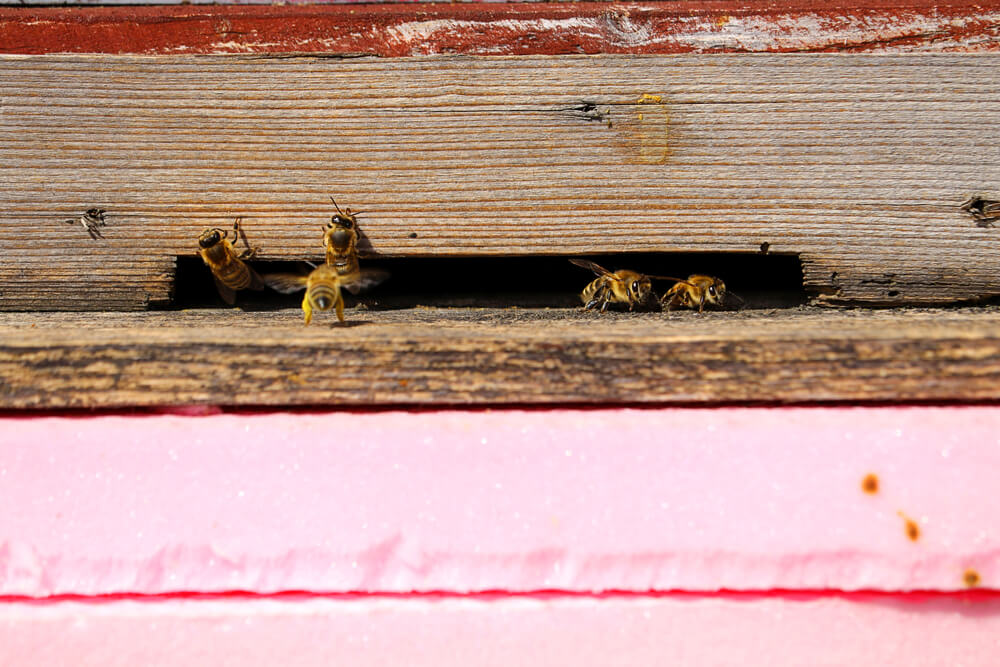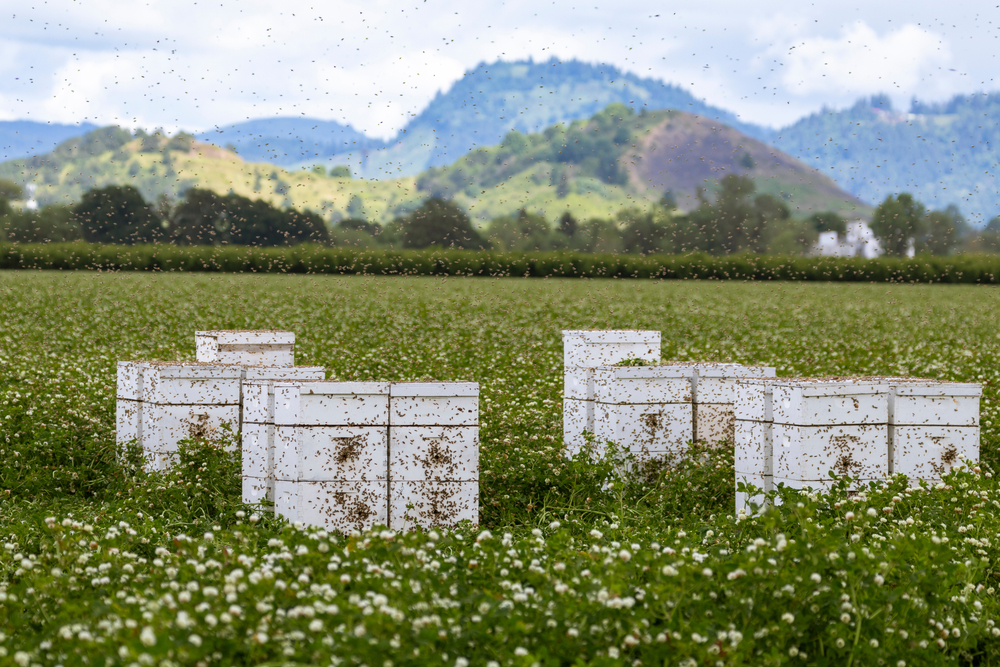Honeybees Are Feeling the Heat
In the Pacific Northwest, extreme temperatures and recurring drought are disrupting the health of essential bee colonies.
Honeybees Are Feeling the Heat
In the Pacific Northwest, extreme temperatures and recurring drought are disrupting the health of essential bee colonies.

Honeybees are durable creatures, but they need water to rely on when temperatures get high.by sunday pictures, Shutterstock.
During the 2020 wildfire season, among the worst in Oregon, Joe Hansen and his family evacuated thousands of bee hives after hot and dry winds pushed a wildfire toward their apiary in the Cascade Mountain foothills. It moved fast, and the beekeeper couldn’t reach his honeybees in the timberlands, where they once reveled in the pollinator paradise of subalpine willowherbs.
“We just couldn’t get to them. On Sunday night, the fire started and then Monday morning the air was full of smoke. By the afternoon, we had to send the crew home because of the conditions. I think that night we evacuated, and [first responders] kind of let us back in, past the roadblocks, to get our bees along with other people who were trying to evacuate their livestock,” Hansen recalls. “But the bees in the upper yards, it was too late. They burned up.”
He lost a few hundred hives to the Riverside Fire in September 2020 that relentlessly spread to more than 138,000 acres, a size so big that the nearby city of Portland could fit within it.
Forty years ago, when Hansen’s father started Foothills Honey Company, hot and long summers were rare. But, over the last few decades, temperatures have increased about two degrees across the Pacific Northwest and drought conditions are more prevalent, according to the Oregon Climate Change Research Institute.
With each summer comes new records set for extremely high temperatures. Last year, a heat dome brought 119°F temperatures to some parts of Oregon. That’s nearly hot enough to melt honeycombs. When exposed to temperatures above 120°F, combs heavy with honey are at risk of falling out of beekeepers’ frames, according to Oregon State University, where researchers work with beekeepers such as the Hansen family.
Honeybees are durable creatures, and they try to cool their hives. They will find water, create a bubble with their mouth, fly it to their hive and drop the water in. Beekeepers have started to keep tubs of water by their hives, but there’s not much they can do for the moisture-deprived plants on which their bees rely. It means the bees don’t have much to forage—especially in warmer fall months, which cause the bees to stay active for longer than usual.
“There’s a period when we’re worried about the bees shutting down,” Hansen says. “They should be getting ready for winter, and instead, they’re in full flight. We don’t want them doing that because they’re using energy and eating food that they should control saving for winter.” Without the right nutrition going into winter months, especially for bees born in August and September, bees become weak or die. While one of the most important pollinators for regional crops such as apples and cherries, honeybees are not native in the Pacific Northwest, which adds a layer of complexity because their survival is dependent on beekeeper management. They need natural forage in order to be strong enough to pollinate crops on a large scale or make honey.

Most natural forage in the Pacific Northwest, such as dandelions, offer about five weeks of significant bloom for pollinators. But as drought makes that time frame shorter and less consistent, people such as Kelly Kulhanek, a postdoctoral researcher at Washington State University’s Hopkins Honey Bee Lab, are trying to find solutions. Her experiments are done in collaboration with commercial beekeepers, where she applies and monitors different food products and treatments to colonies.
Kulhanek works mostly with migratory beekeepers from Central Washington who lease their hives to pollinate large orchards like those in California, where almond trees provide a rich food source. For the honeybees that survive, they come back strong and the colonies get big. But, sometimes, the bees’ homecoming coincides with a dry spring where plants haven’t bloomed. That happened last spring, and beekeepers turned to supplemental feeding.
“You can feed them artificial pollen. It’s protein powder and this kind of dry powder that you mix into pollen patties,” says Kulhanek. “There’s also sugar water or high-fructose corn syrup. But neither of those are as nutritious as natural pollen and nectar that have different amino acids and micronutrients. It’s extra money to spend to feed them those artificial food sources, and you know it’s not as good as the natural source.”
Some beekeepers are creating their own plant stands with seed mixes for pollinators, but that requires space, money and a reliable source of water. Even with flowering plants that are drought tolerant, nectar secretion and pollen shedding can still be affected by soil that doesn’t have enough moisture.
And for smaller beekeepers such as Rob Rienstra, whose Western Washington apiary has just under 1,000 hives, it’s not an easy investment. “There’s not a practical way that I can plant enough of anything to just feed my bees. You couldn’t just do one crop if you did; you would have to choose many,” he says. “In warmer and drier years, plant blooms go very fast, like three and a half weeks. In those years, we get a significantly lower honey yield. I’m talking about like half of what a normal year is.”
His solution is to move his bees to the mountains when he can get the proper permitting from the United States Forest Service. He brings them into higher elevation near Mount Baker (in the Baker-Snoqualmie National Forest) because the altitude helps delay blooming and provides natural forage later in the season.
For both large-scale commercial operations and small, family-owned apiaries, there isn’t a one-size-fits-all fix when it comes to how to take care of their bees as the climate changes. Kulhanek points to two options that will be most likely to unfold in the coming years.
“One option is that you move your bees to somewhere that’s not experiencing drought or as extreme heat, but a lot of what’s difficult about beekeeping is finding good land to keep your bees on,” she says. “And that leaves the other option, which is to do extra management to make up for the things that aren’t blooming the way they should. For us, that usually takes the form of additional supplemental feeding like artificial pollen.”
Kulhanek believes that improving bee health in the long term will take a multifaceted approach by the entire industry. It’s why she, her team and commercial beekeepers continue to research thousands of colonies in an effort to keep honeybees humming in the Pacific Northwest.
Follow us
This work is licensed under a Creative Commons Attribution-NoDerivatives 4.0 International License.
Want to republish a Modern Farmer story?
We are happy for Modern Farmer stories to be shared, and encourage you to republish our articles for your audience. When doing so, we ask that you follow these guidelines:
Please credit us and our writers
For the author byline, please use “Author Name, Modern Farmer.” At the top of our stories, if on the web, please include this text and link: “This story was originally published by Modern Farmer.”
Please make sure to include a link back to either our home page or the article URL.
At the bottom of the story, please include the following text:
“Modern Farmer is a nonprofit initiative dedicated to raising awareness and catalyzing action at the intersection of food, agriculture, and society. Read more at <link>Modern Farmer</link>.”
Use our widget
We’d like to be able to track our stories, so we ask that if you republish our content, you do so using our widget (located on the left hand side of the article). The HTML code has a built-in tracker that tells us the data and domain where the story was published, as well as view counts.
Check the image requirements
It’s your responsibility to confirm you're licensed to republish images in our articles. Some images, such as those from commercial providers, don't allow their images to be republished without permission or payment. Copyright terms are generally listed in the image caption and attribution. You are welcome to omit our images or substitute with your own. Charts and interactive graphics follow the same rules.
Don’t change too much. Or, ask us first.
Articles must be republished in their entirety. It’s okay to change references to time (“today” to “yesterday”) or location (“Iowa City, IA” to “here”). But please keep everything else the same.
If you feel strongly that a more material edit needs to be made, get in touch with us at [email protected]. We’re happy to discuss it with the original author, but we must have prior approval for changes before publication.
Special cases
Extracts. You may run the first few lines or paragraphs of the article and then say: “Read the full article at Modern Farmer” with a link back to the original article.
Quotes. You may quote authors provided you include a link back to the article URL.
Translations. These require writer approval. To inquire about translation of a Modern Farmer article, contact us at [email protected]
Signed consent / copyright release forms. These are not required, provided you are following these guidelines.
Print. Articles can be republished in print under these same rules, with the exception that you do not need to include the links.
Tag us
When sharing the story on social media, please tag us using the following: - Twitter (@ModFarm) - Facebook (@ModernFarmerMedia) - Instagram (@modfarm)
Use our content respectfully
Modern Farmer is a nonprofit and as such we share our content for free and in good faith in order to reach new audiences. Respectfully,
No selling ads against our stories. It’s okay to put our stories on pages with ads.
Don’t republish our material wholesale, or automatically; you need to select stories to be republished individually.
You have no rights to sell, license, syndicate, or otherwise represent yourself as the authorized owner of our material to any third parties. This means that you cannot actively publish or submit our work for syndication to third party platforms or apps like Apple News or Google News. We understand that publishers cannot fully control when certain third parties automatically summarize or crawl content from publishers’ own sites.
Keep in touch
We want to hear from you if you love Modern Farmer content, have a collaboration idea, or anything else to share. As a nonprofit outlet, we work in service of our community and are always open to comments, feedback, and ideas. Contact us at [email protected].by Ashli Blow, Modern Farmer
June 11, 2022
Modern Farmer Weekly
Solutions Hub
Innovations, ideas and inspiration. Actionable solutions for a resilient food system.
ExploreShare With Us
We want to hear from Modern Farmer readers who have thoughtful commentary, actionable solutions, or helpful ideas to share.
SubmitNecessary cookies are absolutely essential for the website to function properly. This category only includes cookies that ensures basic functionalities and security features of the website. These cookies do not store any personal information.
Any cookies that may not be particularly necessary for the website to function and are used specifically to collect user personal data via analytics, ads, other embedded contents are termed as non-necessary cookies.
hhhhhhhhhhhhh